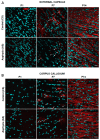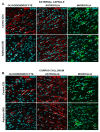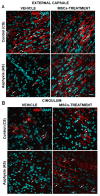Neonatal Mesenchymal Stem Cell Treatment Improves Myelination Impaired by Global Perinatal Asphyxia in Rats
- PMID: 33806988
- PMCID: PMC8004671
- DOI: 10.3390/ijms22063275
Neonatal Mesenchymal Stem Cell Treatment Improves Myelination Impaired by Global Perinatal Asphyxia in Rats
Abstract
The effect of perinatal asphyxia (PA) on oligodendrocyte (OL), neuroinflammation, and cell viability was evaluated in telencephalon of rats at postnatal day (P)1, 7, and 14, a period characterized by a spur of neuronal networking, evaluating the effect of mesenchymal stem cell (MSCs)-treatment. The issue was investigated with a rat model of global PA, mimicking a clinical risk occurring under labor. PA was induced by immersing fetus-containing uterine horns into a water bath for 21 min (AS), using sibling-caesarean-delivered fetuses (CS) as controls. Two hours after delivery, AS and CS neonates were injected with either 5 μL of vehicle (10% plasma) or 5 × 104 MSCs into the lateral ventricle. Samples were assayed for myelin-basic protein (MBP) levels; Olig-1/Olig-2 transcriptional factors; Gglial phenotype; neuroinflammation, and delayed cell death. The main effects were observed at P7, including: (i) A decrease of MBP-immunoreactivity in external capsule, corpus callosum, cingulum, but not in fimbriae of hippocampus; (ii) an increase of Olig-1-mRNA levels; (iii) an increase of IL-6-mRNA, but not in protein levels; (iv) an increase in cell death, including OLs; and (v) MSCs treatment prevented the effect of PA on myelination, OLs number, and cell death. The present findings show that PA induces regional- and developmental-dependent changes on myelination and OLs maturation. Neonatal MSCs treatment improves survival of mature OLs and myelination in telencephalic white matter.
Keywords: apoptosis; hypomyelination; mesenchymal stem cells; myelination; neonatal asphyxia/ischemia; neuroinflammation; oligodendrocyte; periventricular leukomalacia; rat brain; telencephalon.
Conflict of interest statement
The authors declare no conflict of interest. The funders had no role in the design of the study; in the collection, analyses, or interpretation of data; in the writing of the manuscript, or in the decision to publish the results.
Figures







Similar articles
-
Sustained Energy Deficit Following Perinatal Asphyxia: A Shift towards the Fructose-2,6-bisphosphatase (TIGAR)-Dependent Pentose Phosphate Pathway and Postnatal Development.Antioxidants (Basel). 2021 Dec 29;11(1):74. doi: 10.3390/antiox11010074. Antioxidants (Basel). 2021. PMID: 35052577 Free PMC article. Review.
-
Intranasal Administration of Mesenchymal Stem Cell Secretome Reduces Hippocampal Oxidative Stress, Neuroinflammation and Cell Death, Improving the Behavioral Outcome Following Perinatal Asphyxia.Int J Mol Sci. 2020 Oct 21;21(20):7800. doi: 10.3390/ijms21207800. Int J Mol Sci. 2020. PMID: 33096871 Free PMC article.
-
The Long-Term Impairment in Redox Homeostasis Observed in the Hippocampus of Rats Subjected to Global Perinatal Asphyxia (PA) Implies Changes in Glutathione-Dependent Antioxidant Enzymes and TIGAR-Dependent Shift Towards the Pentose Phosphate Pathways: Effect of Nicotinamide.Neurotox Res. 2019 Oct;36(3):472-490. doi: 10.1007/s12640-019-00064-4. Epub 2019 Jun 11. Neurotox Res. 2019. PMID: 31187430
-
Chondroitin sulfate proteoglycans impede myelination by oligodendrocytes after perinatal white matter injury.Exp Neurol. 2015 Jul;269:213-23. doi: 10.1016/j.expneurol.2015.03.026. Epub 2015 Apr 8. Exp Neurol. 2015. PMID: 25862289
-
Therapeutic Strategies for Leukodystrophic Disorders Resulting from Perinatal Asphyxia: Focus on Myelinating Oligodendrocytes.Mol Neurobiol. 2018 May;55(5):4388-4402. doi: 10.1007/s12035-017-0647-7. Epub 2017 Jun 28. Mol Neurobiol. 2018. PMID: 28660484 Free PMC article. Review.
Cited by
-
Mesenchymal stem cells transplantation combined with IronQ attenuates ICH-induced inflammation response via Mincle/syk signaling pathway.Stem Cell Res Ther. 2023 May 15;14(1):131. doi: 10.1186/s13287-023-03369-6. Stem Cell Res Ther. 2023. PMID: 37189208 Free PMC article.
-
PSB0788 ameliorates maternal inflammation-induced periventricular leukomalacia-like injury.Bioengineered. 2022 Apr;13(4):10224-10234. doi: 10.1080/21655979.2022.2061296. Bioengineered. 2022. Retraction in: Bioengineered. 2022 Jun;13(6):14856. doi: 10.1080/21655979.2022.2163545. PMID: 35436416 Free PMC article. Retracted.
-
Sustained Energy Deficit Following Perinatal Asphyxia: A Shift towards the Fructose-2,6-bisphosphatase (TIGAR)-Dependent Pentose Phosphate Pathway and Postnatal Development.Antioxidants (Basel). 2021 Dec 29;11(1):74. doi: 10.3390/antiox11010074. Antioxidants (Basel). 2021. PMID: 35052577 Free PMC article. Review.
-
Mitochondrial dysfunction in perinatal asphyxia: role in pathogenesis and potential therapeutic interventions.Mol Cell Biochem. 2021 Dec;476(12):4421-4434. doi: 10.1007/s11010-021-04253-8. Epub 2021 Sep 1. Mol Cell Biochem. 2021. PMID: 34472002 Review.
References
-
- Volpe J.J. Neurology of the Newborn. WB Saunders; London, UK: 1995. Hypoxic-Ischemic encephalopathy: Neuropathology and pathogenesis; pp. 279–313.
-
- Herrera-Marschitz M., Morales P., Leyton L., Bustamante D., Klawitter V., Espina-Marchant P., Allende C., Lisboa F., Cunich G., Jara-Cavieres A., et al. Perinatal asphyxia: Current status and approaches towards neuroprotective strategies, with focus on sentinel proteins. Neurotox. Res. 2011;19:603–627. doi: 10.1007/s12640-010-9208-9. - DOI - PMC - PubMed
-
- Herrera-Marschitz M., Neira-Peña T., Rojas-Mancilla E., Espina-Marchant P., Esmar D., Pérez R., Muñoz V., Gutierrez-Hernandez M., Rivera B., Simola N., et al. Perinatal asphyxia: CNS development and deficits with delayed onset. Front. Neurosci. 2014;8:47. doi: 10.3389/fnins.2014.00047. - DOI - PMC - PubMed
MeSH terms
Substances
Grants and funding
LinkOut - more resources
Full Text Sources
Other Literature Sources
Research Materials
Miscellaneous

